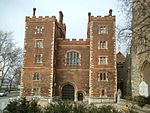Hercules Road

Hercules Road runs north from Lambeth Road near Lambeth Palace, on the site of Penlington Place, in the London Borough of Lambeth, south London, England.The road is named after Hercules Hall, which was built by and was the home of Philip Astley (1742–1814), riding instructor, horse-trainer, and acknowledged as the inventor of the modern circus. Performing nearby in an open field behind the present site of St John's Church, Waterloo, Astley realised the advantages of riding in a circle, and thus invented the circus ring. He was a principal among the many performers who made Lambeth a popular entertainment resort at that time. Historically, Hercules Road is most well known for a former resident, the poet and visionary artist William Blake (1757–1827), who lived in a large house, 13 Hercules Buildings, and his address was Mr Blake Engraver, Hercules Buildings, Westminster Bridge. There is a series of mosaics inspired by Blake in a tunnel nearby. The site is marked with a plaque. Hercules Road was a location for the film Passport to Pimlico. At the conclusion of filming, the site had to be returned to the same bomb-damaged state as before, to enable the locals to claim war damage compensation. It is also the setting for Tracy Chevalier's 2007 novel Burning Bright. The Pineapple public house is located at 53–55 Hercules Road.
Excerpt from the Wikipedia article Hercules Road (License: CC BY-SA 3.0, Authors, Images).Hercules Road
Hercules Road, London Lambeth (London Borough of Lambeth)
Geographical coordinates (GPS) Address Nearby Places Show on map
Geographical coordinates (GPS)
| Latitude | Longitude |
|---|---|
| N 51.496666666667 ° | E -0.11472222222222 ° |
Address
Dark Sphere
Hercules Road 186
SE1 7LD London, Lambeth (London Borough of Lambeth)
England, United Kingdom
Open on Google Maps








